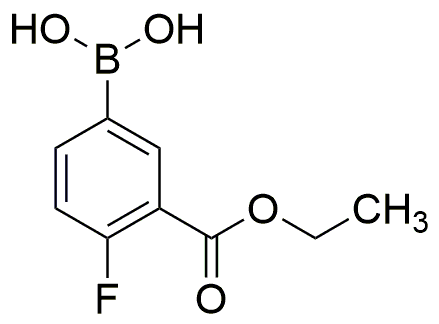3-(Ethoxycarbonyl)-4-fluorophenylboronic acid is widely utilized in research focused on:
- Pharmaceutical Development: This compound serves as a key intermediate in the synthesis of various pharmaceuticals, particularly in the development of drugs targeting cancer and other diseases. Its boronic acid functionality allows for selective reactions that are crucial in medicinal chemistry.
- Organic Synthesis: It is employed in Suzuki coupling reactions, which are essential for forming carbon-carbon bonds. This application is particularly valuable in the production of complex organic molecules, making it a staple in organic chemistry labs.
- Material Science: The compound is used in the creation of advanced materials, including polymers and nanomaterials. Its unique properties enhance the performance of materials in electronics and coatings, offering improved durability and functionality.
- Agricultural Chemistry: It finds applications in the synthesis of agrochemicals, such as herbicides and pesticides. The ability to modify its structure allows for the development of more effective and environmentally friendly agricultural products.
- Diagnostic Tools: This chemical is also utilized in the development of diagnostic agents, particularly in imaging techniques. Its properties can be leveraged to improve the sensitivity and specificity of various diagnostic tests.
General Information
Properties
Safety and Regulations
Applications
3-(Ethoxycarbonyl)-4-fluorophenylboronic acid is widely utilized in research focused on:
- Pharmaceutical Development: This compound serves as a key intermediate in the synthesis of various pharmaceuticals, particularly in the development of drugs targeting cancer and other diseases. Its boronic acid functionality allows for selective reactions that are crucial in medicinal chemistry.
- Organic Synthesis: It is employed in Suzuki coupling reactions, which are essential for forming carbon-carbon bonds. This application is particularly valuable in the production of complex organic molecules, making it a staple in organic chemistry labs.
- Material Science: The compound is used in the creation of advanced materials, including polymers and nanomaterials. Its unique properties enhance the performance of materials in electronics and coatings, offering improved durability and functionality.
- Agricultural Chemistry: It finds applications in the synthesis of agrochemicals, such as herbicides and pesticides. The ability to modify its structure allows for the development of more effective and environmentally friendly agricultural products.
- Diagnostic Tools: This chemical is also utilized in the development of diagnostic agents, particularly in imaging techniques. Its properties can be leveraged to improve the sensitivity and specificity of various diagnostic tests.
Documents
Safety Data Sheets (SDS)
The SDS provides comprehensive safety information on handling, storage, and disposal of the product.
Product Specification (PS)
The PS provides a comprehensive breakdown of the product’s properties, including chemical composition, physical state, purity, and storage requirements. It also details acceptable quality ranges and the product's intended applications.
Certificates of Analysis (COA)
Search for Certificates of Analysis (COA) by entering the products Lot Number. Lot and Batch Numbers can be found on a product’s label following the words ‘Lot’ or ‘Batch’.
*Catalog Number
*Lot Number
Certificates Of Origin (COO)
This COO confirms the country where the product was manufactured, and also details the materials and components used in it and whether it is derived from natural, synthetic, or other specific sources. This certificate may be required for customs, trade, and regulatory compliance.
*Catalog Number
*Lot Number
Safety Data Sheets (SDS)
The SDS provides comprehensive safety information on handling, storage, and disposal of the product.
DownloadProduct Specification (PS)
The PS provides a comprehensive breakdown of the product’s properties, including chemical composition, physical state, purity, and storage requirements. It also details acceptable quality ranges and the product's intended applications.
DownloadCertificates of Analysis (COA)
Search for Certificates of Analysis (COA) by entering the products Lot Number. Lot and Batch Numbers can be found on a product’s label following the words ‘Lot’ or ‘Batch’.
*Catalog Number
*Lot Number
Certificates Of Origin (COO)
This COO confirms the country where the product was manufactured, and also details the materials and components used in it and whether it is derived from natural, synthetic, or other specific sources. This certificate may be required for customs, trade, and regulatory compliance.


